Quality control in construction is the regimented process of ensuring that the quality of all materials, systems, and components used in a construction project meet the established standards. It is an essential aspect that influences the safety, durability, and efficiency of buildings, roads, bridges, and other infrastructures we use daily. Quality control is more than just inspecting the final product – it encompasses testing materials, observing processes, and fixing issues that can impact the final result. In this article, we are going to focus on one particular element that lies at the heart of many construction projects – concrete, and discuss the quality control procedures for concrete as per the standards of the American Concrete Institute (ACI).
The American Concrete Institute (ACI) is a leading authority and resource center for the development, distribution, and adoption of consensus-based standards regarding concrete design, construction, and materials. ACI has been instrumental in shaping the design and construction methodologies in concrete structures worldwide. The comprehensive guidelines and quality control procedures set forth by the ACI are adhered to by professionals across the globe to ensure concrete durability, safety, and sustainability.
Concrete is an indispensable construction material, known for its strength and versatility. However, its quality can significantly vary based on the materials used, mixing proportions, and curing methods. These variations in quality can lead to substantial differences in the strength, durability, and resilience of the constructed infrastructure. Thus, quality control in concrete production and placement is paramount to achieving long-lasting and safe structures.
Quality control procedures for concrete in construction is a proactive approach that allows construction teams to anticipate and address potential problems before they become costly or dangerous. It involves verifying the quality of the raw materials, monitoring the concrete production process, inspecting the placement of concrete, and testing the hardened concrete to ensure it meets the designed specifications. The ACI provides detailed procedures and guidelines for each of these steps to ensure the highest quality concrete is used in every construction project.
From creating the concrete mix design to testing the final product, each stage of the process is crucial to producing quality concrete. Therefore, an understanding of the ACI’s Quality control procedures for concrete is an essential tool for construction professionals worldwide. By following these standards, builders and developers can ensure their concrete structures are not only strong and durable but are also constructed to withstand the test of time and the varying forces of nature.
Throughout the rest of this article, we are discussing in depth about the Quality control procedures for concrete outlined by the ACI, offering insights into the various tests conducted to ensure the quality of concrete, how these procedures are implemented in the field, and why these measures are essential in maintaining the integrity and longevity of concrete structures.
In essence, quality control in construction, as stipulated by the ACI, stands as a testament to an unwavering commitment towards ensuring safety and durability. By upholding these stringent guidelines, construction projects around the world can achieve a benchmark of excellence, ensuring every concrete structure built is of the highest possible quality. Let’s take a closer look at what these quality control procedures entail and how they impact the world of concrete construction.
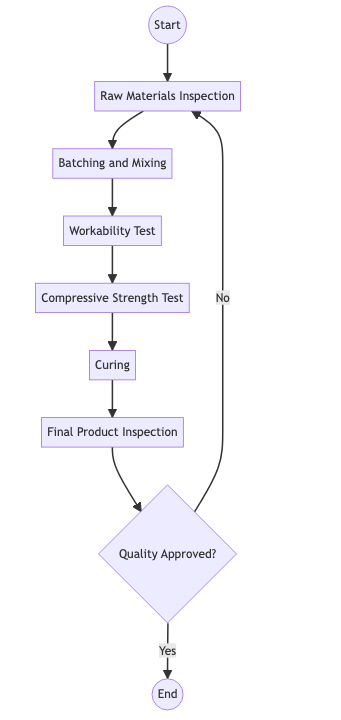
1. Importance of Quality Control in Concrete Construction
Concrete construction forms the backbone of the modern world’s infrastructure. From towering skyscrapers to expansive bridges, concrete’s robust and adaptable nature makes it an ideal material for a myriad of construction projects. However, like any other construction material, concrete’s effectiveness is largely dependent on the quality of its composition and the processes used in its installation. Thus, understanding the importance of quality control in concrete construction is critical for any construction professional.
Quality control, as the name suggests, is the process of ensuring that the quality of a product or service meets or exceeds the expected standards. In the context of concrete construction, quality control involves a series of checks and balances designed to ensure that the concrete used in a construction project is of the highest quality. These measures range from inspecting the raw materials to monitoring the mixing process, and testing the final product.
Concrete is a composite material, made up of a mixture of aggregates (such as sand and gravel), cement, and water. The proportions of these components, along with additional additives, can drastically affect the properties of the resulting concrete. Too much water, for example, can weaken the concrete, while too little can make it unworkable. Therefore, controlling the quality of these components and their proportions is vital to producing a durable and strong final product.
The quality control process begins with the inspection of raw materials. Each material is assessed for its suitability for use in the concrete mix. This includes evaluating the size and shape of aggregates, the type and quality of cement, and the cleanliness of the water. The ACI provides clear guidelines on what these standards should be, helping ensure consistency across projects.
Once the raw materials have been approved, they are combined in specific proportions to form the concrete mix. The exact proportions can vary based on the intended use of the concrete, but the ACI provides guidelines to help ensure that the resulting mixture is workable, durable, and strong. Monitoring the mixing process is a critical part of quality control, ensuring that the materials are thoroughly mixed and that the correct proportions are maintained throughout.
After the concrete mix has been created, it must be properly placed and cured. The methods used during these stages can significantly affect the concrete’s final properties. Quality control measures during these stages ensure that the concrete is evenly distributed, that it properly adheres to any reinforcing materials, and that it is cured under the right conditions to reach its maximum strength.
Finally, once the concrete has hardened, it can be tested to ensure it meets the required standards. This can include tests for strength, durability, and permeability, among others. The ACI provides guidelines for conducting these tests, helping to ensure that any issues are quickly identified and addressed.
Therefore, the importance of quality control in concrete construction cannot be overstated. The ACI’s guidelines provide a clear framework for assessing the quality of concrete, helping to ensure that it meets the rigorous demands of modern construction. By adhering to these guidelines, construction professionals can ensure that their concrete structures are built to last, providing safety and reliability for years to come.
Moreover, quality control is not just about ensuring the final product is up to standard. It is a continuous process that involves constant monitoring and adjusting, aimed at preventing defects before they occur. The implementation of thorough quality control procedures leads to better project outcomes, increased client satisfaction, and fewer delays and cost overruns due to rework. It is the cornerstone of every successful concrete construction project and is the assurance we have that our buildings and infrastructures are safe, durable, and reliable.
2. ACI Standards for Concrete Quality Control
Ensuring quality in construction is a mission of paramount importance, and when it comes to concrete construction, the American Concrete Institute (ACI) sets the standards. ACI guidelines for concrete quality control are robust, comprehensive, and established through rigorous research and extensive industry experience. The goal is simple: to ensure that every phase of the concrete production, placement, and curing process yields the best possible results in terms of strength, durability, and reliability.
The ACI standards for concrete quality control span a wide range of aspects. They begin with the selection and testing of raw materials, covering every detail from the type and quality of cement, the size and shape of the aggregates, and the quality of water. The composition of concrete can significantly impact its properties, and hence ACI has strict criteria for each component to ensure optimal performance. For instance, the ACI sets specifications for cement regarding its chemical composition, fineness, and strength to ensure consistency and reliability.
Moving on to the concrete mix design, ACI guidelines stipulate the appropriate proportions of the raw materials to create a concrete mix that is strong, workable, and durable. The mix design varies depending on the project requirements, environmental conditions, and the desired characteristics of the concrete. ACI standards guide professionals in designing a concrete mix that balances all these factors, leading to a high-quality end product.
Quality control during the mixing process is another crucial area covered by the ACI standards. Proper mixing ensures a uniform distribution of the components, resulting in a homogenous and efficient concrete mix. ACI provides guidelines on the duration of mixing, the order of adding materials, and even the type of mixer to be used. These specifics ensure that the resulting concrete mix has the desired properties and performance characteristics.
The placement of concrete is equally significant in determining the final quality of a concrete structure. ACI guidelines address the process of transporting, placing, compacting, and finishing the concrete. The standards focus on minimizing segregation, maintaining homogeneity, and ensuring the concrete is correctly placed and compacted to avoid voids and achieve the desired shape and surface finish.
Curing is the final step in the process, and it greatly influences the properties of the hardened concrete. The ACI provides detailed guidelines on curing methods and durations, which can vary based on the type of construction and environmental conditions. Proper curing ensures that the concrete achieves its maximum potential strength and durability.
The scope of ACI’s guidelines for quality control doesn’t stop here. The institute also provides standards for non-destructive testing of the hardened concrete. These tests are crucial for assessing the in-place properties of the concrete, such as its strength, permeability, and durability. By conducting these tests, construction professionals can identify any potential issues and take corrective measures if necessary.
In essence, the ACI standards for concrete quality control are designed to encompass every aspect of concrete construction, from the selection of raw materials to the final testing of the completed structure. These standards are established based on scientific principles and have been proven effective in ensuring the quality of concrete in thousands of projects worldwide. By following these guidelines, construction professionals can confidently produce concrete structures that are strong, durable, and built to last.
Quality control as per ACI guidelines is not merely a set of rules to follow but a systematic approach to excellence. It is the constant pursuit of better methods, improved materials, and superior practices. Through these guidelines, the ACI continues to play a vital role in shaping the world of concrete construction, guiding the industry towards safer, more sustainable, and higher quality outcomes.
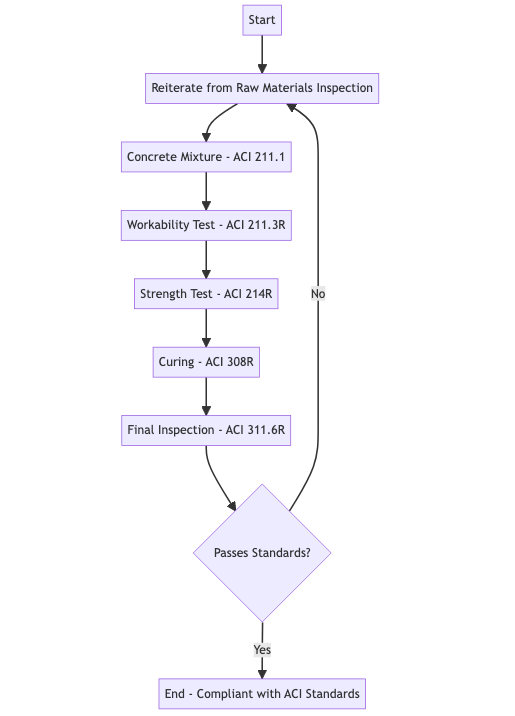
3. Material Quality Control
In the world of concrete construction, one of the fundamental elements of success is the quality of the materials used. Ensuring the quality of concrete materials is a critical step in the concrete production process, which is why the American Concrete Institute (ACI) provides detailed guidelines for material quality control.
Concrete is a composite material made up of three primary components: aggregates (sand, gravel, or crushed stone), cement, and water. Additionally, concrete may also contain supplementary materials such as fly ash, slag cement, or chemical admixtures to improve its properties. The quality of each of these components plays a vital role in determining the properties of the final concrete product, influencing factors such as strength, durability, workability, and finish.
Aggregates typically constitute about 60% to 75% of the concrete’s volume. They provide structure to the concrete and largely determine its mechanical properties. ACI guidelines emphasize the importance of using aggregates that are clean, hard, strong, and durable. They also recommend using well-graded aggregates, which have a mix of sizes to fill the gaps and reduce the amount of cement and water needed. The ACI provides detailed procedures for testing the aggregates, which includes checking for impurities, assessing the size and shape, and determining the abrasiveness and alkali-silica reactivity.
Cement acts as the binding agent that holds the aggregates together. The quality of cement is crucial because it directly affects the strength and durability of the concrete. ACI guidelines state that the cement should be uniform in quality and color, and it should be stored in a dry area to prevent moisture damage. Tests for cement include checking the fineness, consistency, setting time, and compressive strength.
Water, though a seemingly simple component, plays an indispensable role in the chemistry of concrete. The water used in concrete should be clean and free from harmful amounts of oils, acids, alkalis, or organic materials. It should not contain any substances that may interfere with the setting, hardening, or strength of the concrete. ACI guidelines provide clear specifications for the acceptable quality of mixing water.
Finally, ACI guidelines also cover the use of supplementary materials and admixtures. These materials, while not always necessary, can greatly enhance the properties of the concrete. They can improve workability, reduce water demand, increase strength, and even provide special properties such as resistance to chemicals or freeze-thaw cycles. ACI standards specify when and how these materials should be used and tested, ensuring they enhance rather than detract from the final product.
In essence, material quality control is about ensuring that each component of the concrete contributes positively to the final product. Each material should be carefully selected, tested, and handled to ensure it meets the required standards. The aim is to produce a concrete mix that not only has the desired properties but is also consistent from batch to batch, ensuring reliable performance in the field.
Quality control of concrete materials is not just about adhering to standards; it’s about understanding the profound impact each component has on the properties of the final product. By following ACI’s rigorous material quality control guidelines, construction professionals can ensure that every batch of concrete they produce is of the highest possible quality, ready to serve its purpose in creating strong, durable, and reliable structures.
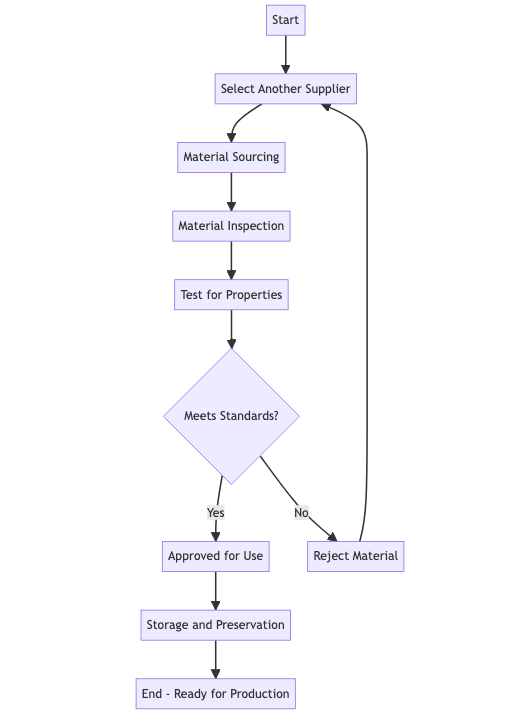
4. Mix Design Control
A critical aspect of quality control in concrete construction is the control of the mix design. The mix design refers to the specific combination of the various ingredients that go into making concrete. These include the aggregates, cement, water, and any additional admixtures or supplementary materials. The American Concrete Institute (ACI) provides thorough guidelines for mix design control, ensuring that each batch of concrete is consistent, reliable, and meets the specific needs of each construction project.
ACI’s mix design guidelines begin with the determination of the requirements for the concrete. This includes considering the expected loads the concrete will carry, the exposure conditions it will face (such as freeze-thaw cycles, chemical exposure, or high temperatures), and any specific requirements of the construction process (such as the need for high workability or early strength gain). Understanding these requirements is crucial for selecting the right mix design.
Once the requirements have been determined, the next step in the mix design process is the selection of the ingredients. The ACI provides guidelines for selecting the types and proportions of aggregates, the type of cement, and any necessary admixtures or supplementary materials. This involves balancing the properties of the individual materials to achieve the desired properties in the final concrete.
The proportions of the ingredients are critical for achieving the desired properties of the concrete. Too much or too little of any ingredient can lead to problems such as reduced strength, decreased durability, or poor workability. ACI’s mix design guidelines provide methods for determining the right proportions of the ingredients based on their properties and the requirements of the concrete. These methods consider factors such as the size and shape of the aggregates, the type and amount of cement, and the desired workability and strength of the concrete.
Monitoring the mixing process is another crucial aspect of mix design control. The mixing process needs to be long enough to ensure that the materials are thoroughly combined, but not so long that it leads to segregation or a reduction in workability. ACI guidelines provide recommendations on the mixing process, including the order of adding the ingredients and the duration of mixing.
Finally, once the mix has been created, it must be tested to ensure it meets the required specifications. The ACI provides guidelines for testing the fresh concrete, including tests for workability (such as the slump test), air content, and temperature. These tests are essential for catching any potential issues before the concrete is placed.
But the testing doesn’t stop with the fresh concrete. Once the concrete has hardened, it must be tested again to ensure it has achieved the required strength and durability. The ACI provides guidelines for these tests as well, helping to ensure that the final product meets the rigorous demands of modern construction.
Hence, mix design control is a critical aspect of quality control in concrete construction. By carefully selecting the ingredients and their proportions, monitoring the mixing process, and thoroughly testing the resulting concrete, construction professionals can ensure they produce a high-quality product that meets the specific needs of each project. ACI’s mix design control guidelines provide a robust framework for achieving this goal, promoting consistency, reliability, and excellence in concrete construction.
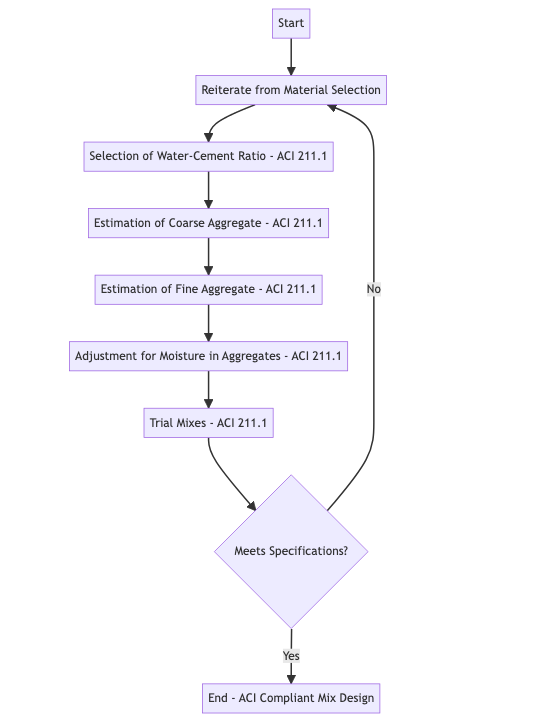
5. Production Control
Quality control in the production of concrete is a complex process that requires meticulous attention to detail. The American Concrete Institute (ACI) has developed comprehensive guidelines that govern each step of the production process, ensuring consistency, reliability, and the high-quality performance of the final product.
The production process for concrete begins with the batching of the ingredients, a critical step that determines the proportion of each component in the mix. ACI guidelines stipulate precise controls over batching. These include accuracy requirements for measuring equipment, guidelines for weighing or volumetric batching, and instructions for sequence and timing of batching operations. Every detail matters; even minor deviations in the proportion of ingredients can affect the properties of the concrete.
Once the ingredients have been batched, they need to be mixed. ACI guidelines cover all aspects of the mixing process. This includes specifying the type of mixer that should be used, the mixing speed, and the duration of mixing. These guidelines ensure that the concrete mix is homogeneous, meaning the ingredients are evenly distributed throughout. A homogenous mix is crucial for the concrete to achieve consistent strength and durability.
Transporting the mixed concrete to the construction site is another area that is governed by ACI guidelines. The transport process should ensure that the concrete maintains its properties from the time it is mixed until it is placed. The guidelines provide instructions on various aspects of transportation, including the type of transport vehicle, the duration of transport, and how to prevent segregation or loss of workability during transport.
The process of placing the concrete at the construction site also comes under the purview of ACI’s production control guidelines. Correct placement is crucial to ensure that the concrete fills the formwork evenly and voids are minimized. The guidelines cover various aspects of placement, including the method of delivery (such as pumping or direct placement), the need to avoid segregation, and the techniques for consolidating the concrete to remove air voids.
Curing is the final step in the production process, a critical phase that determines the ultimate strength and durability of the concrete. ACI guidelines provide detailed instructions on curing, including the recommended methods (such as water curing or the use of curing compounds), the required duration of curing, and the environmental conditions that need to be maintained during curing.
ACI’s production control guidelines do not end with the completion of construction. They also cover non-destructive testing of the hardened concrete, to verify that it has achieved the desired properties. These tests include methods for assessing the concrete’s strength, permeability, and resistance to environmental damage. By conducting these tests, construction professionals can ensure that the final product has met the required standards.
Thus, the production control guidelines provided by the ACI are comprehensive and precise, covering every step of the concrete production process. They ensure that the entire process, from the batching of the ingredients to the final testing of the hardened concrete, is carried out to the highest standards. By following these guidelines, construction professionals can confidently produce high-quality concrete that is reliable, durable, and fit for purpose. It is this commitment to excellence that makes the ACI’s production control guidelines an essential tool for anyone involved in concrete construction.
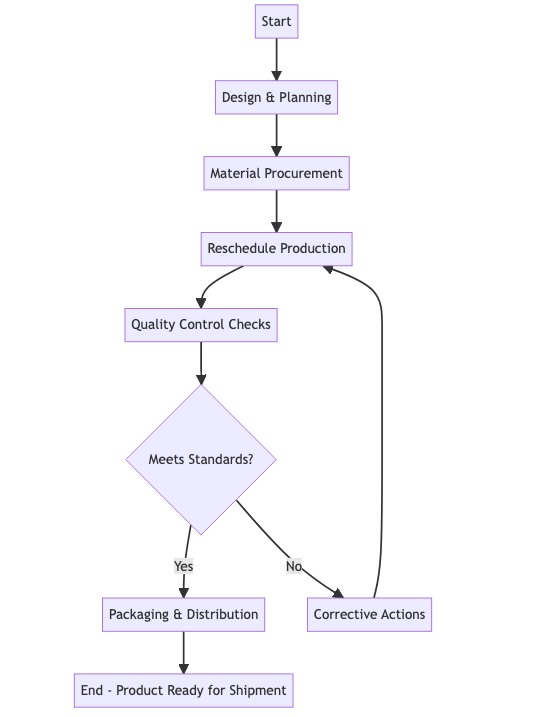
6. Workmanship Control
Workmanship is a critical component in the quality of a concrete construction project. No matter how carefully materials are selected, how meticulously mix designs are prepared, or how strictly production processes are controlled, poor workmanship can still lead to a substandard final product. The American Concrete Institute (ACI) recognizes the importance of this aspect and provides robust guidelines for workmanship during concrete installation.
Workmanship control begins with the proper training and qualification of the personnel involved in the construction process. ACI guidelines recommend that all personnel, from the concrete mixers to the installers, be properly trained and knowledgeable about their role in the project. They should understand the critical aspects of their work and the potential impacts of improper execution.
Proper workmanship control also involves the correct handling and placement of the concrete mix. ACI guidelines emphasize the importance of minimizing the time between mixing and placement to prevent the concrete from starting to set before it has been properly positioned. Concrete should be placed as close to its final position as possible to avoid segregation, a condition where the aggregate and cementitious materials separate from each other.
The concrete must also be adequately consolidated once it is placed. Consolidation involves removing entrapped air from the concrete, usually by vibration. This process helps to ensure that the concrete fully occupies the space within the formwork and around any reinforcement. ACI provides detailed guidelines on the proper techniques and equipment for consolidation, including how to select the right type of vibrator and how to use it effectively.
After placement and consolidation, the concrete needs to be finished. Finishing involves creating a smooth, even surface and can include any additional texturing or decorative elements. ACI’s guidelines provide instructions on the correct timing and techniques for finishing. They emphasize the need to avoid over-finishing, which can weaken the surface of the concrete and lead to problems such as scaling or crazing (formation of fine cracks).
Finally, workmanship control also includes proper curing of the concrete. Curing is the process of maintaining the concrete’s moisture and temperature conditions to allow it to gain strength. ACI provides specific guidelines for curing, including the recommended methods, durations, and environmental conditions. The curing process is critical for achieving the desired strength and durability in the concrete, and it should be carefully monitored and controlled.
Hence, workmanship control is a vital aspect of quality control in concrete construction. Even with the best materials and most carefully designed mix, poor workmanship can lead to a substandard final product. The American Concrete Institute’s guidelines provide a robust framework for ensuring good workmanship, covering everything from the qualification of personnel to the techniques for placement, consolidation, finishing, and curing. By adhering to these guidelines, construction professionals can ensure that every aspect of their work contributes to the quality and reliability of the finished concrete structure.
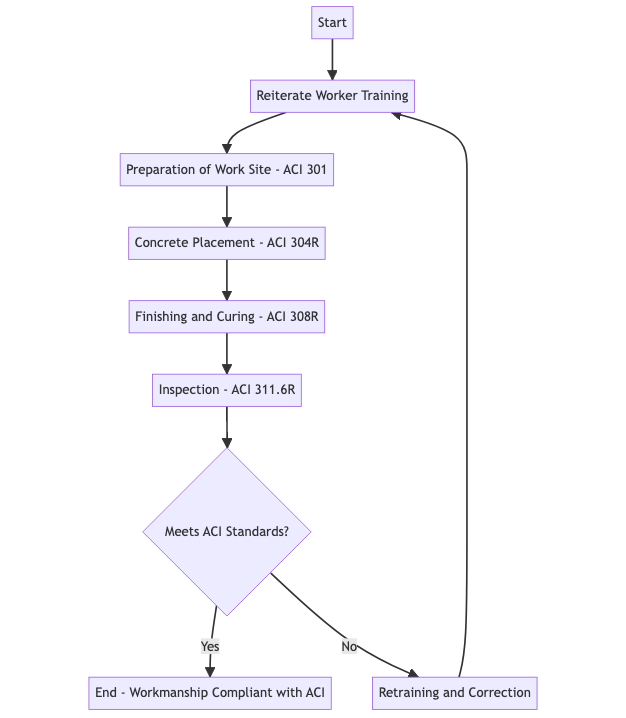
7. Testing and Performance Control
In concrete construction, the quality control process isn’t complete without thorough testing and performance control. The American Concrete Institute (ACI) provides comprehensive guidelines on testing protocols to ensure the durability, strength, and overall quality of the concrete used in projects. The objective of these tests is not only to evaluate the properties of the hardened concrete but also to verify the effectiveness of the quality control processes throughout the production and installation phases.
ACI’s concrete testing guidelines start from the initial stage of mix design. Tests are performed to determine the properties of the concrete components (aggregates, cement, water, and admixtures) and the fresh concrete mix. These tests cover various aspects like workability (using tests such as slump test), air content, and temperature, among others. The intent behind these tests is to ensure that the concrete mix is as per the designed mix proportions and is suitable for the intended application.
Once the concrete has been placed and hardened, ACI guidelines stipulate a series of tests to assess the performance of the concrete. The most common test is the compressive strength test, typically carried out on cylindrical samples that are cured and tested at specific ages (often at 7 and 28 days). The compressive strength test is crucial as it provides an indication of the concrete’s ability to withstand loads.
Apart from the compressive strength test, other tests are recommended depending on the specific requirements of a project. These can include tests for permeability (to assess the concrete’s resistance to water penetration), freeze-thaw durability, and resistance to chemical attack. For structures exposed to aggressive environments, such tests can be particularly critical in determining whether the concrete will stand up to the conditions it will face.
In addition to these standard tests, ACI also provides guidelines for non-destructive testing methods. These can be used to assess the condition of a structure without damaging it and can provide valuable information on the uniformity of the concrete, the presence of cracks or defects, and the extent of any potential damage. Techniques include rebound hammer tests, ultrasonic pulse velocity tests, and ground-penetrating radar, each of which can provide valuable information about the concrete’s condition.
Finally, ACI’s guidelines stipulate a continuous process of performance control. This is achieved through routine monitoring of the concrete’s performance throughout its service life, including regular visual inspections and non-destructive testing. Such performance control not only helps in identifying any potential problems at an early stage but also contributes to the further development of concrete technology by providing feedback on the effectiveness of current practices.
Hence, testing and performance control are integral parts of ACI’s quality control procedures for concrete construction. By carrying out a comprehensive series of tests from the initial stages of mix design through to the hardened concrete, construction professionals can ensure that the finished product meets the specified requirements and will perform well throughout its service life. Such a rigorous approach to testing and performance control is a testament to ACI’s commitment to promoting excellence in concrete construction.
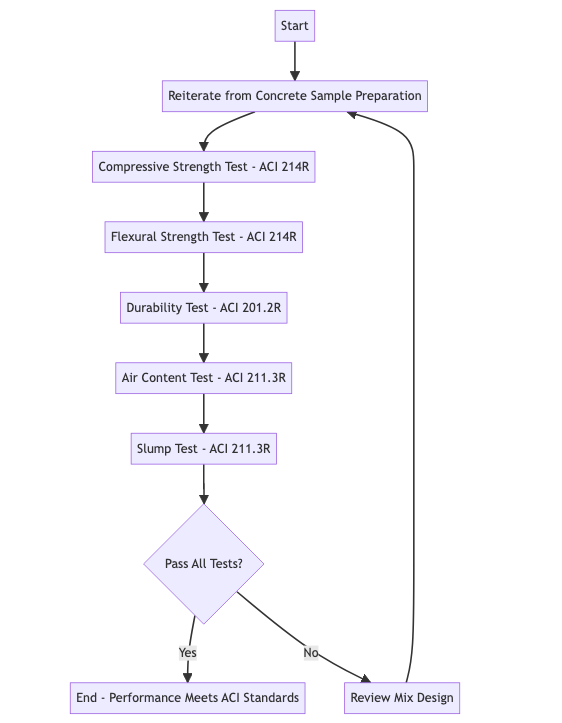
8. Documentation and Compliance
The success of any quality control system hinges not just on the practical steps taken to ensure a high-quality product, but also on the robustness of the system’s documentation and the strictness of its compliance procedures. In concrete construction, the American Concrete Institute (ACI) underscores the significance of detailed, accurate documentation and rigorous compliance with its standards.
Documentation plays a pivotal role in the quality control process. It offers a written record of every aspect of a project, from the initial planning and design stages through to the final tests on the completed structure. This information can prove invaluable for identifying potential issues, verifying compliance, and providing a historical record that can guide future projects.
ACI’s guidelines stipulate that accurate records should be kept for every phase of a concrete construction project. These records can include mix design details, raw material sources and test results, batch and production records, transport and placement details, curing methods and durations, test results on fresh and hardened concrete, and any observations or incidents noted during the construction process.
For the mix design, for example, documentation should include the proportions of each ingredient, the type and source of each material, and any admixtures used. It should also record the intended properties of the mix, such as its workability, strength, and durability, and the results of any tests carried out on the mix.
For the production process, documentation should cover the details of the batching, mixing, transportation, placement, and curing processes. This includes the equipment used, the times and durations of each process, the conditions under which the work was carried out, and any incidents or deviations from the planned process.
The documentation of test results is particularly important. ACI requires that test results be recorded accurately and in detail, including the methods used, the conditions at the time of testing, and the actual results. This data provides a crucial record of the performance of the concrete and can help in identifying any potential issues or trends.
Compliance with ACI’s standards is ensured through a combination of internal controls and external audits. Project managers and quality control personnel are responsible for ensuring that the guidelines are followed on a day-to-day basis. This includes monitoring the production and installation processes, conducting the necessary tests, and keeping accurate records.
External audits are also crucial for ensuring compliance. These can be carried out by independent bodies or by clients themselves, and they involve a detailed review of the project’s quality control procedures and documentation. Any non-compliance identified during these audits needs to be addressed promptly to prevent potential issues with the quality of the concrete.
Therefore, documentation and compliance are cornerstones of the quality control procedures set forth by the American Concrete Institute. By keeping accurate records and strictly adhering to ACI’s standards, construction professionals can ensure that their concrete products are of the highest possible quality, meeting the demands of their projects and contributing to the integrity and longevity of their structures.
FAQ’s
What is ACI in concrete construction?
ACI stands for the American Concrete Institute. It’s a leading authority and resource worldwide for the development and distribution of consensus-based standards, technical resources, and educational programs about concrete design and construction.
What are the key quality control procedures in concrete construction according to ACI?
Key quality control procedures as per ACI include material selection, mix design control, production control, workmanship control, testing, and performance control. Each procedure aims to ensure the quality and longevity of the concrete structures.
What is the role of testing in ACI’s quality control procedures for concrete?
Testing is crucial in ACI’s quality control procedures to verify the properties of both fresh and hardened concrete. Tests like compressive strength, permeability, air content, and slump test, among others, are carried out to confirm the concrete meets desired standards.
How does ACI ensure compliance with its standards in concrete construction?
ACI ensures compliance through a combination of internal controls, external audits, and accurate documentation. Project managers and quality control personnel adhere to the guidelines daily, while independent bodies carry out external audits.
What is the importance of mix design control in ACI quality control procedures?
Mix design control is crucial as it determines the proportions of cement, aggregate, water, and admixtures in the concrete. A well-controlled mix design ensures the concrete achieves the desired strength, workability, and durability.
Why does ACI emphasize documentation in quality control procedures for concrete?
Documentation provides a critical record of every phase of a project, allowing potential issues to be identified, compliance to be verified, and serving as a historical record for future projects.
What does workmanship control mean in ACI’s quality control procedures?
Workmanship control refers to the correct handling and placement of the concrete mix, the adequate consolidation of the placed concrete, the proper finishing techniques, and the right curing methods.
What are the standards for concrete quality control by ACI?
ACI provides numerous standards for concrete quality control. Some of the key standards include ACI 301 (Specifications for Structural Concrete), ACI 304R (Guide for Measuring, Mixing, Transporting, and Placing Concrete), and ACI 311.6 (Specification for Testing Ready Mixed Concrete).
How does ACI’s guidelines help in material quality control in concrete construction?
ACI guidelines provide parameters for selecting suitable materials for concrete, considering factors like strength, durability, and workability. The guidelines cover the selection and testing of cement, aggregates, water, and admixtures.
What is the significance of production control in ACI’s quality control procedures?
Production control involves the careful monitoring of batching, mixing, transportation, and placement processes to ensure that the prepared concrete is consistent with the mix design. Proper production control helps to maintain the quality, uniformity, and performance of the concrete.
Read More


1 thought on “Quality Control Procedures for Concrete as per ACI”